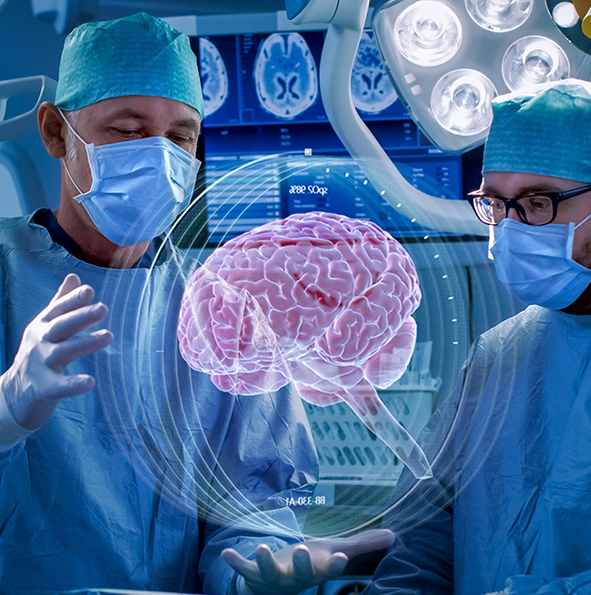
There are many different kinds of disc surgeries performed to relieve spinal or back pain like Laminectomy (spinal decompression), Foraminotomy (to relieve pressure on the nerves that are compressed by the intervertebral foramina, Endoscopic spine surgery, and Microdiscectomy. A Microscopic Lumbar Disc Surgery involves Microdiscectomy.
Also known as minimally invasive spine surgery, Microdiscectomy involves a small incision and the use of surgical loupes or a microscope to magnify the injured site.
A microdiscectomy is a surgical operation performed to relieve pain and other symptoms caused by pressure on a nearby nerve root by a herniated disc in the spine. Throughout the procedure, the physician extracts tiny pieces of bone, ligament, and disc to release the nerve.
One of three minimally invasive methods—a midline, tubular, or endoscopic microdiscectomy—can be used to reach the herniated disc and nerve during microdiscectomy surgery.
Traditionally, a discectomy meant removing the entire disc, which meant making a huge incision. Thanks to advanced methods and high-tech equipment, nearly all spine surgeons carry out microdiscectomies. Pain relief from the operation is typically quick, sometimes even instantaneous.
A Midline Microdiscectomy: This involves the surgeon making a vertical incision in the back that is one to two inches long, lifting the muscles around the vertebrae, and using devices to hold the layers of tissue apart while the treatment is being performed.
A Tubular Microdiscectomy: This is a less invasive procedure that involves the surgeon making a tiny incision and inserting several tiny tubes or dilators to create a passageway through the muscle that allows for minimal tissue damage.
An Endoscopic Microdiscectomy: It is also referred to as microendoscopic discectomy. It is a technique that requires minimal disruption of surrounding tissues and even smaller incisions. The surgeon uses a miniature camera and instruments in this procedure.
Microdiscectomy success rates are extremely high overall. However, the success of the procedure is largely dependent on the thorough preoperative screening and evaluation, as well as the patient's dedication to maintaining good spine health after the microdiscectomy.
However, it is important to note that some patients with herniated discs also have other spinal problems that result in pain and disability related to the nerves. If it is thought that these problems are causing complications, further treatments like a laminectomy—the removal of the lamina, and the bony lid of the spinal canal—may be necessary for one or more of the vertebrae.
Many people feel sufficiently fit to resume work after resting for 2 weeks off to allow the soft tissues to heal. On the other hand, rehabilitation from a microdiscectomy usually necessitates 6 weeks of modified activity, beginning in week two or three, and includes physical therapy.
Physical therapists concentrate on setting up a home workout routine that will help protect the spine in addition to helping patients strengthen their core muscles and release stiff joints. All patients, especially those whose jobs include physical labor, are advised to gradually return to their prior habits. People in more sedentary employment also need to be aware of their posture and take brief walks or light exercise every hour or so, as sitting in a chair and leaning forward puts strain on the spine.
The aim of the surgery is the same regardless of the specific type of microdiscectomy - to remove the disc fragment together with any bone or ligament that might be pinching the nerve root.
Minimally Invasive: The body experiences lesser trauma from such surgeries. Compared to open surgery, the body heals quicker, and involves less pain, bleeding and scarring.
Impressive Success Rates: The success rate of microdiscectomy is usually high. According to a significant study, 84% of patients who had microdiscectomies reported favorable or excellent outcomes, and the surgery helped them with their mobility issues and ruptured disc pain.
Quick Recovery Time: Patients won’t have to restrict their movements for months after the surgery. After two to four weeks, one should be able to move around easily, and it will take around eight weeks to recover fully.
The spinal cord and nerves are supported and protected by the 26 vertebrae that make up the spine. The spine is susceptible to several illnesses and traumas that can harm the vertebrae, impair movement, and cause discomfort.
At WIINS, we understand that the Spinal Cord being a delicate part of the Nervous System needs expert surgical intervention. This is why, WIINS houses experts with years of experience and a history of successful complex surgeries.
Spine-related conditions like:
Slipped/Herniated Disc
Spinal Cord Tumors
Spinal Fracture
Dislocations
TB Spine
We provide unmatched safety with highly sophisticated technologies like Spinal Navigation, Endoscopy, and Intraoperative Nerve Monitoring.
Our patients have access to a wide range of knowledge to assist in improving their health since our Neurosurgeons, Orthopedic Surgeons, Physiatrists, Pain Physicians, Psychologists, and other experts have vast experience treating even the most difficult spine disorders.

